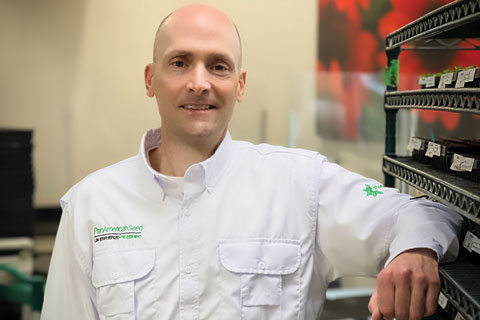12/1/2024
Six Questions for Scott Roskuszka, President of PanAmerican Seed
Chris Beytes

GrowerTalks: I understand you first came to know Ball as an outside auditor working for Arthur Anderson. Did you ever imagine you’d one day head up one of Ball’s key divisions?
Scott Roskuszka: I was the manager on the Ball audit and knew the financial side of the company well. In early 2001, Ball needed another set of hands on their finance team to help manage the consolidation of all the new entities added with the Colegrave Seeds acquisition. When I joined, my first boss, Barrie Ricketts, told me, “If you’re curious and work hard, you’ll have a lot of opportunities at Ball.” Barrie was right! I’ve been fortunate to have a great number of roles within the Ball organization and every opportunity has been exciting. Being considered to lead PanAmerican and following in Anne’s footsteps is a humbling opportunity and a great challenge. What makes this easier, though, is the exceptional team of professionals I work with—from product development through production, operations, sales, marketing and customer service. Making sure this group has the resources to thrive as a team is special.
GT: Anne was president of PAS for more than two decades. How do you think the role has changed over that time?
SR: The market dynamics and competitive landscape have definitely evolved since Anne took over in 1999. Anne built and guided a great team, with a strong focus on quality and reliability of core seed annuals. But as PAS gained success, the market needs evolved, with a shift in mature markets, North America and Europe, to larger finished containers—often with genera not typically available from seed. This is where Anne’s passion for product innovation and her gift of fostering collaboration among breeding, production and product management shined. Anne knew that continued success and growth meant an even greater dedication to the development of seed varieties that meet the changing market needs. Through this evolution, PAS brought many breakthroughs in bacopa, osteospermum, angelonia, echinacea, lobelia, coleus, interspecific impatiens and others.
GT: And what has remained the same? What’s a constant at PAS?
SR: I would say it’s understanding and committing to the delivery of reliable high quality seed supply. One of the hallmarks of Anne’s success was an intense focus on the success of PAS’ distribution company customers and growers they service. PAS is fortunate to own production facilities around the globe that reliably supply our seed, and the leadership and passion at our farms for quality, on-time full delivery of the market’s needs has never been stronger.
GT: You mentioned market dynamics and the competitive landscape. What are your goals, short-term and long-term, for guiding PAS into the future?
SR: First and foremost, ensure complete alignment with our distribution partners globally on supply and demand signals. We don’t want to assume we’ve found a post-COVID balance. We never want to miss an opportunity to fill our customers’ needs … but at the same time, we want to be balanced in how we manage our production and supply.
That’s short-term. Longer-term, we want to ensure that all of our business functions are completely aligned to successfully commercialize our robust pipeline of products in development. And we will be utilizing the advance research capabilities of our development partners at Ball Helix to improve the success and speed of our new product introductions.
Short and long term, we’re always thinking about succession planning. We’re fortunate to be run by long-tenured geniuses in complicated subject matter. Making sure that knowledge is captured and organized for application into the future is an intense focus.
Also both short and long term, by mid-2025, PAS will be a co-tenant/co-operator of the new modernized Seed Distribution Center 2.0 in West Chicago. We’re very excited to deliver even better quality, speed and reliability to seed customers around the globe with this major long-term investment.
GT: What is the future of seed, especially considering the change from cell packs to pots and the competition from vegetative cuttings?
SR: A couple of thoughts on that … first, global sales growth varies by product and geography. Mature markets have seen a gradual decline in the classic flat and bedding seed items, while those products are the foundation of high-potential and emerging markets, like China, India and Southeast Asia.
And think about this: Seed is the ultimate sustainable product. What would require 100 boxes to ship as cuttings can ship in one box as seed. Seed can be stored for years and sown literally in seconds per tray. As true measures of sustainability of our product come into closer focus through the channel, the advantage of seed will be much clearer.
GT: PAS is a global division—how do world affairs, such as the war in Ukraine and tensions with China, affect business operations?
SR: Every day is a new adventure. Our compliance function has broadened significantly over the last several years and we now have integrated “regulatory readiness” into our product development pipeline. Dealing with the uncertainties of geopolitics is stressful. When planning, you need a mindset that collects, evaluates and ultimately accepts the risks of the world we live in today. Gaining market access for our wide range of genetics to all global markets is harder than it has ever been, but we’re steadfast in our commitment to “Color the World.” GT